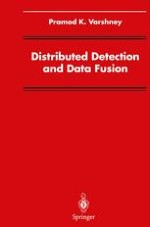1997 | OriginalPaper | Chapter
Distributed Bayesian Detection: Parallel Fusion Network
Author : Pramod K. Varshney
Published in: Distributed Detection and Data Fusion
Publisher: Springer New York
Included in: Professional Book Archive
Activate our intelligent search to find suitable subject content or patents.
Select sections of text to find matching patents with Artificial Intelligence. powered by
Select sections of text to find additional relevant content using AI-assisted search. powered by
As indicated earlier, detection networks can be organized in a number of topological structures. Among the topologies considered in the literature, the parallel fusion topology has received the most attention. In this chapter, we develop the theory of Bayesian detection for parallel fusion structures. In Section 3.2, we consider a parallel structure consisting of a number of detectors whose decisions are available locally and are not transmitted to a fusion center for decision combining. Costs of decision making are assumed to be coupled and a system wide optimization is carried out for binary and ternary hypothesis testing problems. Section 3.3 considers the design of fusion rules given the statistics of incoming decisions. Design of the parallel fusion network, consisting of a number of local detectors and a fusion center, is the subject of Section 3.4. Person-by-person optimal decision rules are derived. A number of special cases including conditionally independent local observations and identical detectors are considered. Efficient computational approaches are presented. Design of optimal parallel structures with dependent local observations is an NP-complete problem. This and other computational complexity issues are briefly considered. Finally, robust detection and nonparametric detection are discussed at the end of the chapter.
